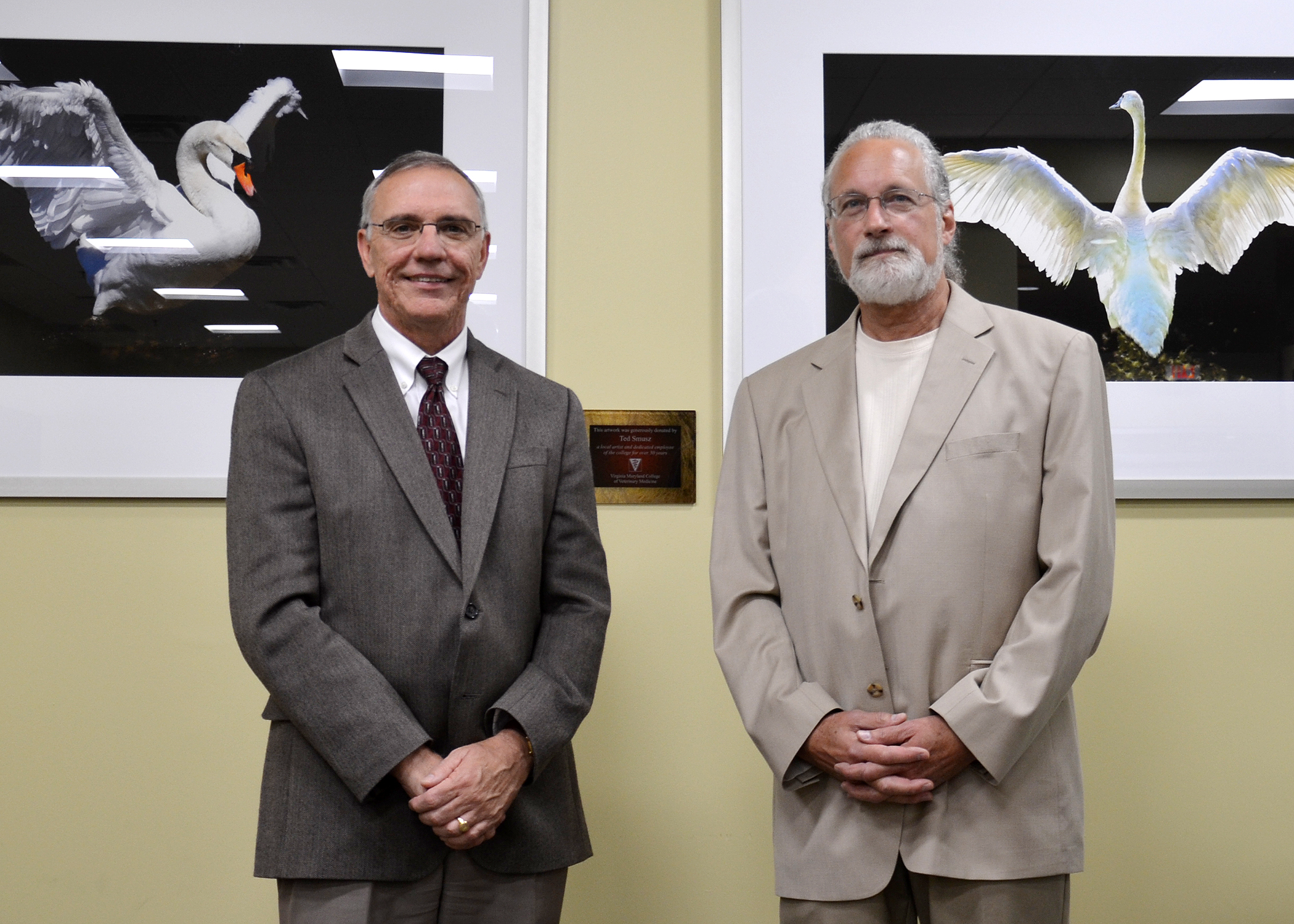Long-time veterinary college employee and digital artist Ted Smusz recognized for generosity

If you’ve ever called the Virginia-Maryland College of Veterinary Medicine at Virginia Tech, there’s a good chance you’ve talked to Ted Smusz. A communications assistant for the Veterinary Teaching Hospital, Smusz works with a six-person team that answers more than 500 calls a day at the hospital switchboard.
The Blacksburg resident is also a self-taught digital photographer and editor, who recently donated his unique animal art to the hospital’s examination rooms and, most recently, a renovated student lounge and library space. Recently, the veterinary college recognized Smusz, who has spent more than 30 years with the college, for his generosity.
To say that Smusz is a patient man is an understatement. “I can spend up to 40 hours on a photo,” said Smusz, whose artistic contributions to the veterinary college are now recognized with a plaque in the student lounge. “I’m not only sizing the photo, but also blowing it up and digitally redrawing it. I do most of it manually to save the skin texture and tone on my subjects.”
The pony-tailed, bespectacled Smusz often spends evenings in his home studio focusing on his art. In addition to a high-resolution digital camera with a variety of lenses, he also has three software programs that allow him to edit photos pixel by pixel.
“I used to be heavily into cars and rebuilding cars. That led to taking photographs of cars,” said Smusz, who spent part of his childhood growing up in Bristol, Connecticut. “When I saw car photos that others had taken, I found the activity in the photo surrounding the cars to be distracting. So I started to think about using a technique I call ‘isolation.’”
Smusz taught himself how to separate a photo’s subject from its environment. Although photographers regularly touch up their photos by fixing the lighting or removing stray hairs, Smusz has taken his skills to the next level. The subjects of his photographs are so striking that they seem to jump off the canvas or page.
“The first time I took animal photographs, I was fishing off the coast of North Carolina and a teenage whale breached close to the boat,” he recalled. “I was lucky enough to get a couple of clear shots which the Duke Marine Lab asked if they could use in their promotional literature. I realized then I could use the same techniques for animal pictures that I had been using on car photos.”
Not all of his artwork uses the “isolation” technique. One of his photos of a calf (a collaboration using an original photograph by Dr. Phil Sponenberg, professor of pathology and genetics) emphasizes the contrast between the red clay on the ground and the white light on the animal, while others of a mandrill (a close relative of a baboon) and a horse have features that appear to be glowing like a creature in a James Cameron film.
Although he takes many of his own photographs, Smusz also applies his techniques to pictures from other photographers. He has even created abstracts by scanning everyday objects and digitally re-mastering them. One photo looks like splashes of orange, purple, blue, and teal from a distance, but upon closer inspection, takes the shape of a geisha holding a fan. Smusz used the fan shape from a fossil he collected for the abstract picture.
“Everything I do is high resolution because it allows me more opportunity to manipulate it,” said Smusz, who turned his attention to photography more than 10 years ago and appreciates the exacting process of editing photos for the creative outlet it gives him. “I couldn’t easily tell you how I do it because I taught myself and have my own technique and process for doing it. Much of what I create is more intuitive than logistical. I work on each picture until it seems ‘right’ to me.”
The 13 works of art in the student lounge and library space became a reality thanks to a team effort. Teresa Ko of Teresa Ko Commercial Interiors in Blacksburg provided consultation on sizing and placement of the art, special projects coordinator Cindi McKenzie had all of the pictures matted and framed, and facilities maintenance assistant Ed Wilson hung the finished products.
An Air Force Vietnam War veteran, Smusz joined the veterinary college in 1982 after answering dispatch calls for ambulatory veterinarians in the area. In 2004, the Virginia Veterinary Medical Association recognized Smusz as a “Friend of the VVMA” for the communications support he provided between referring veterinarians across the state and clinical faculty members in the Veterinary Teaching Hospital. He and his wife, Terry, live close to town and have two adult children, Emily and Ian.







